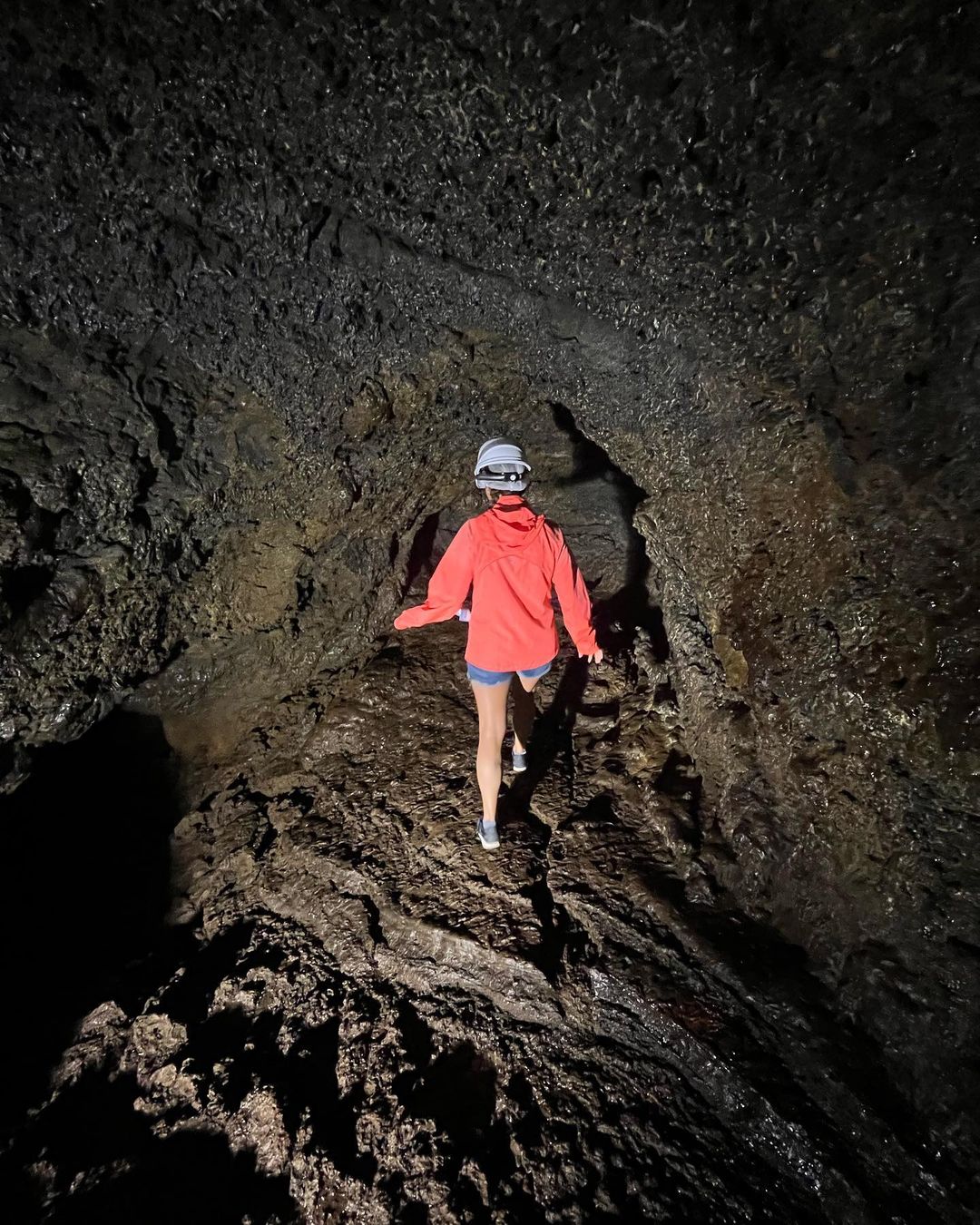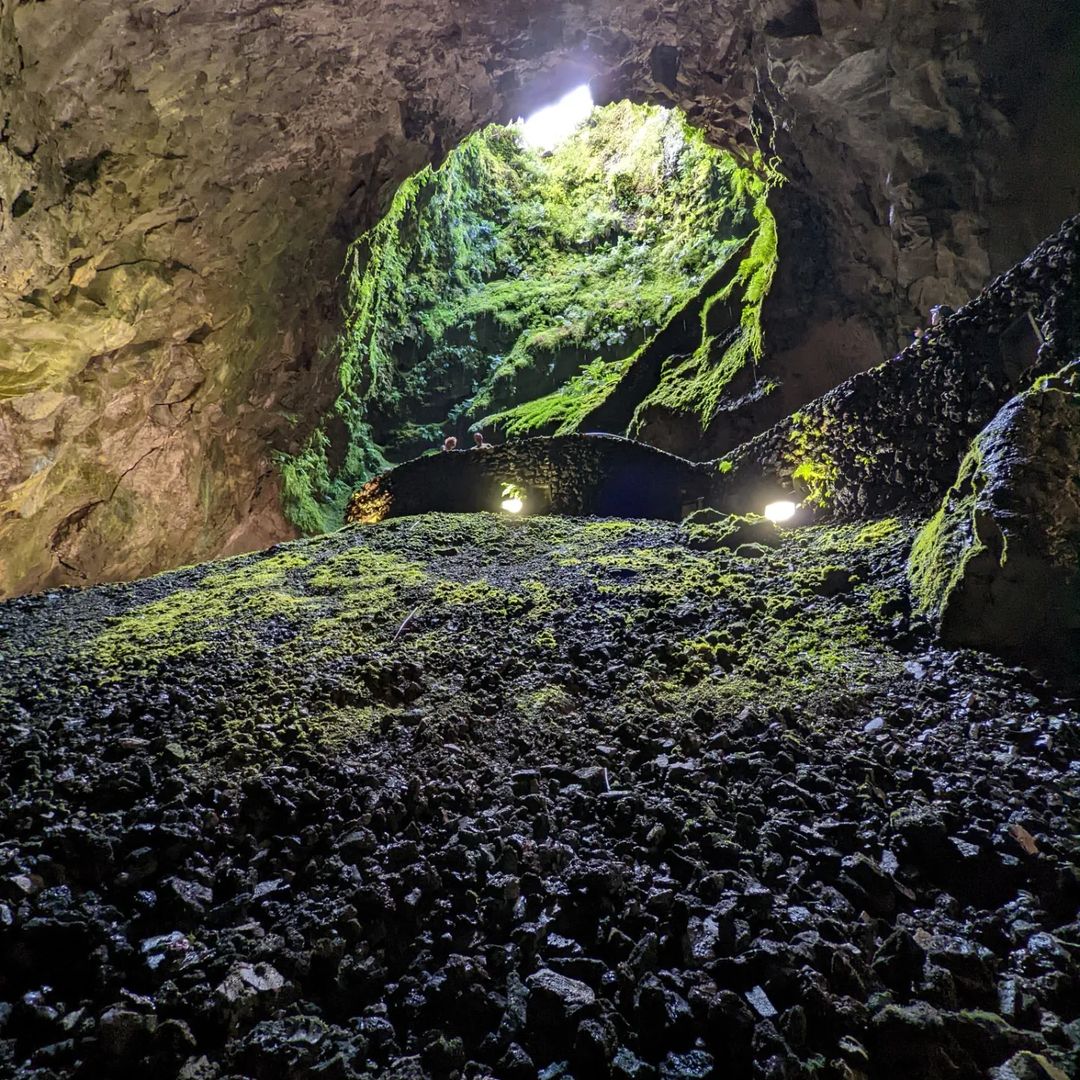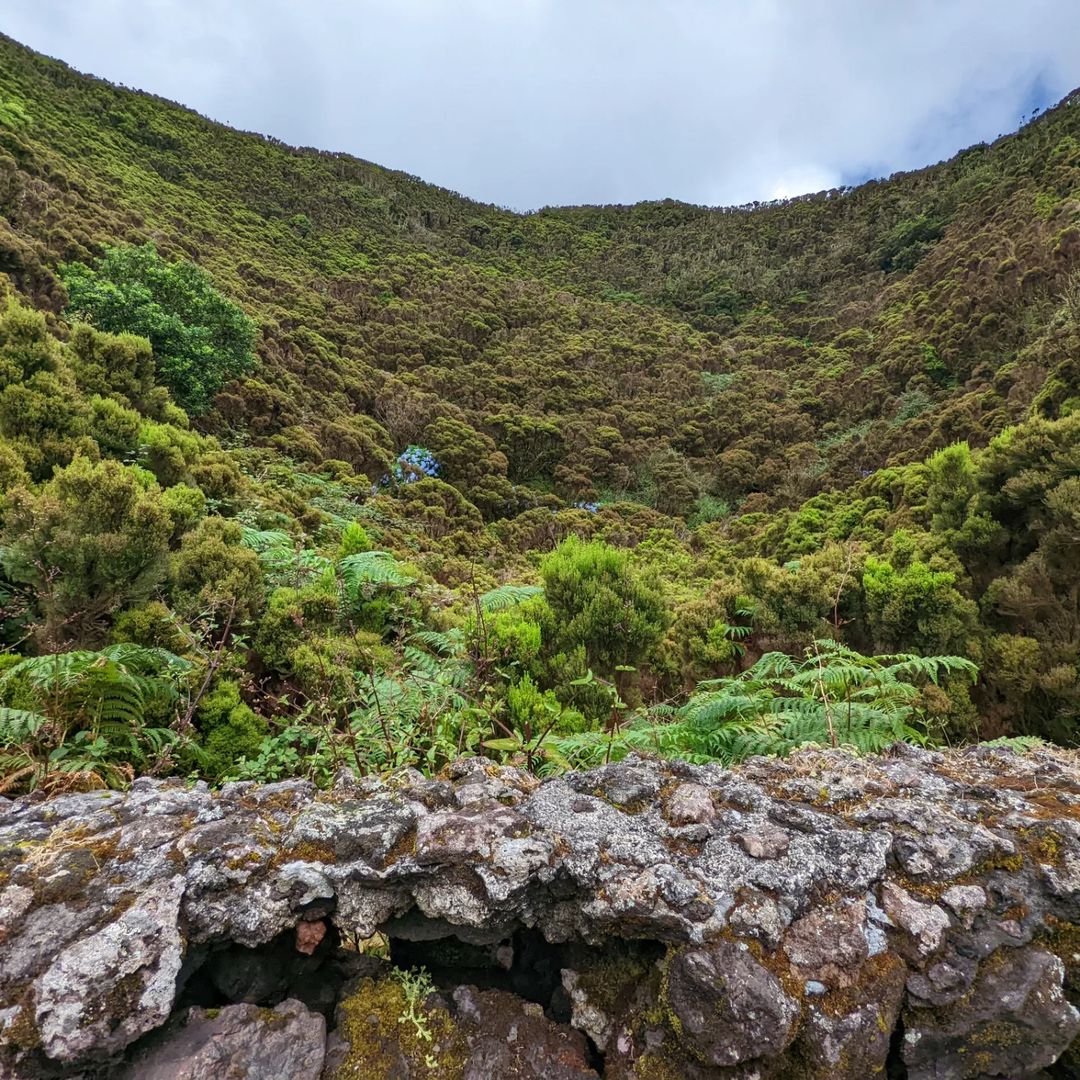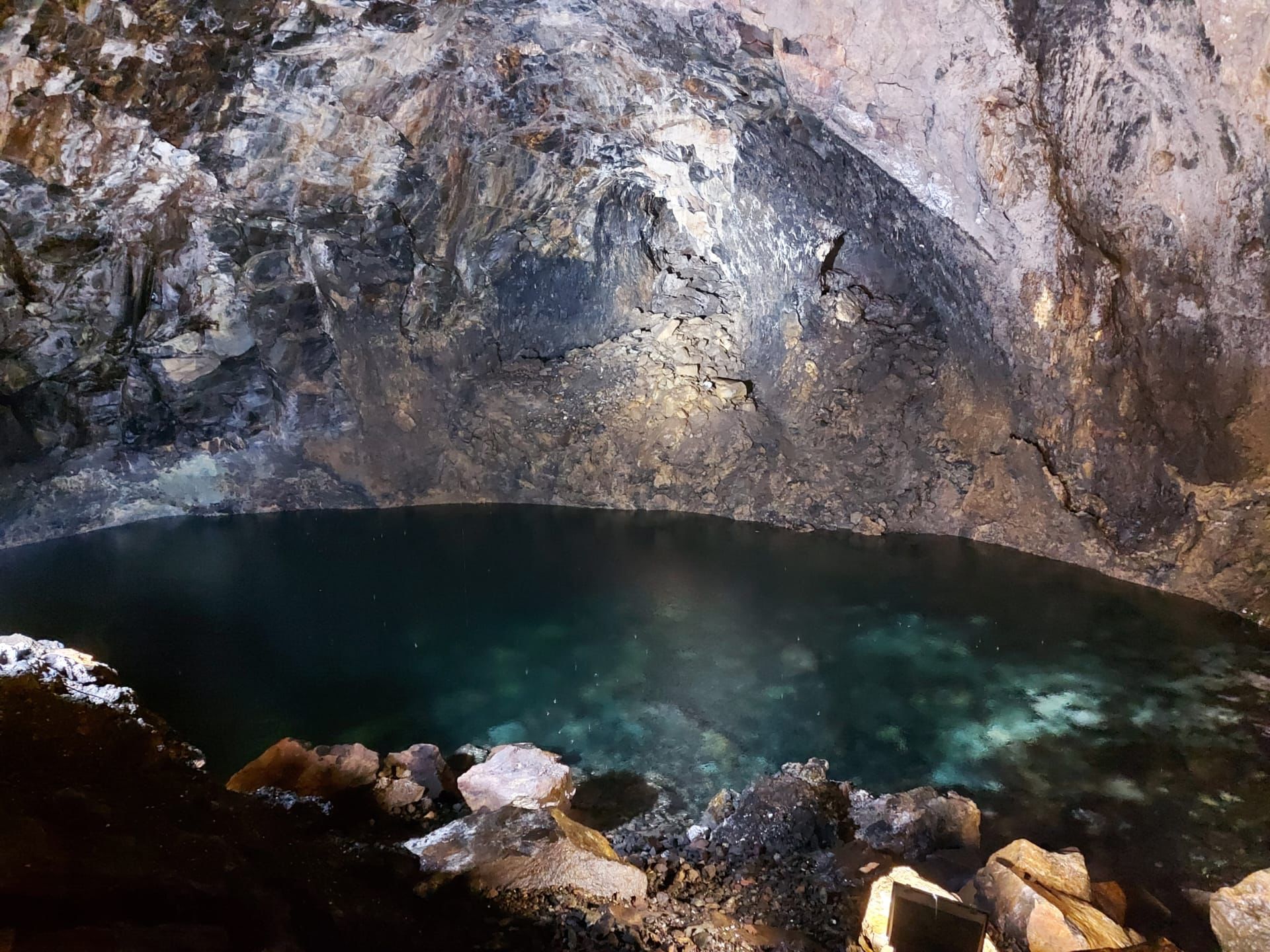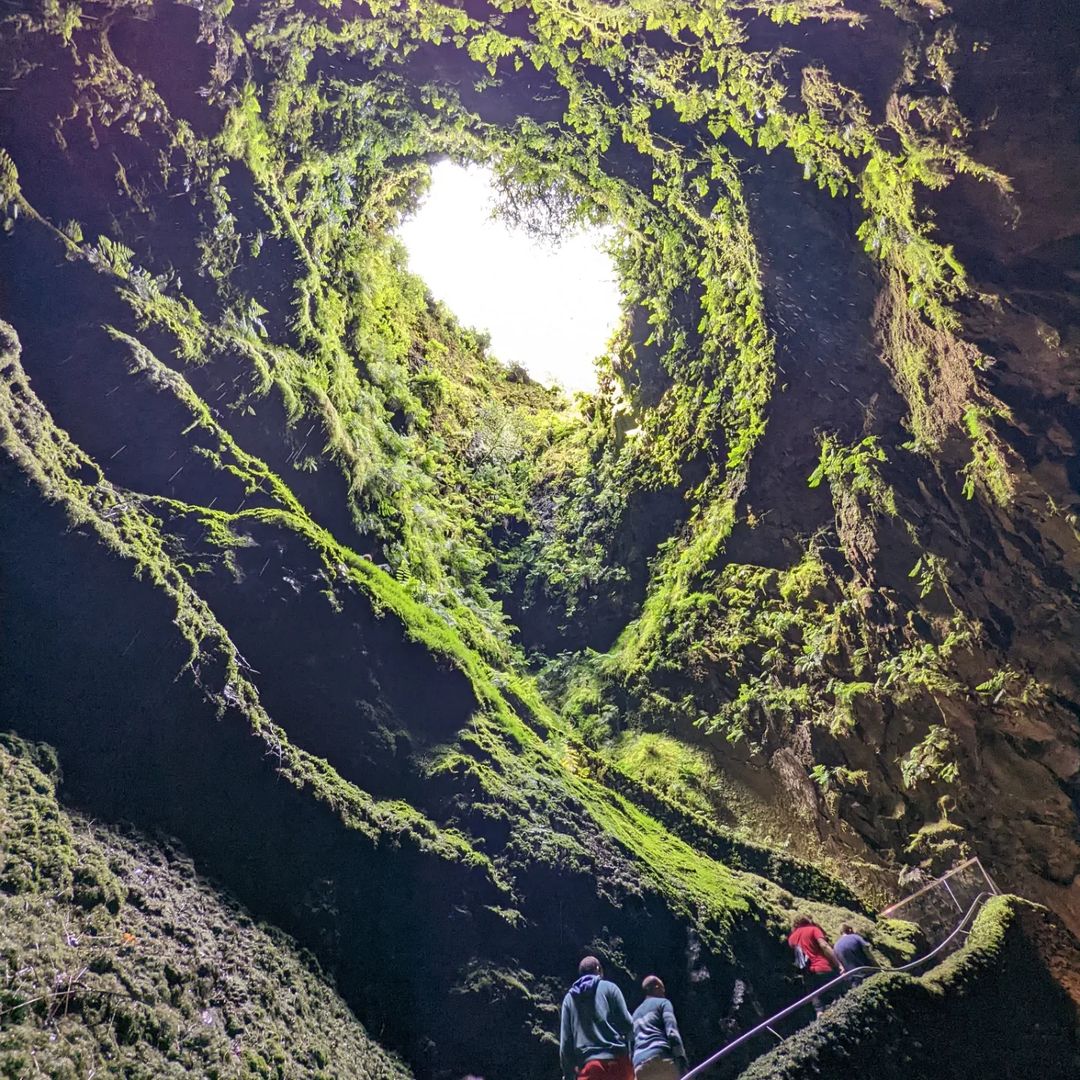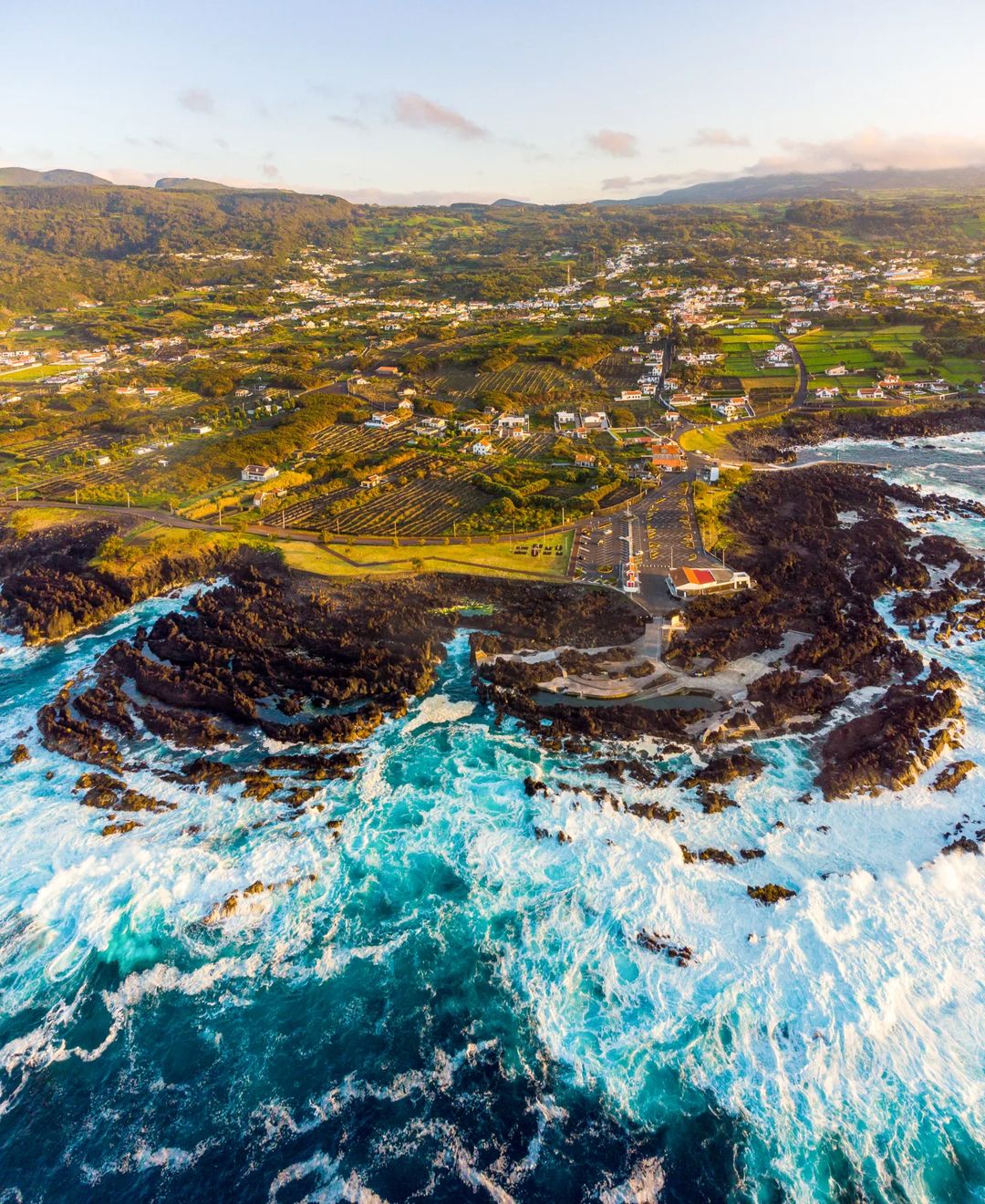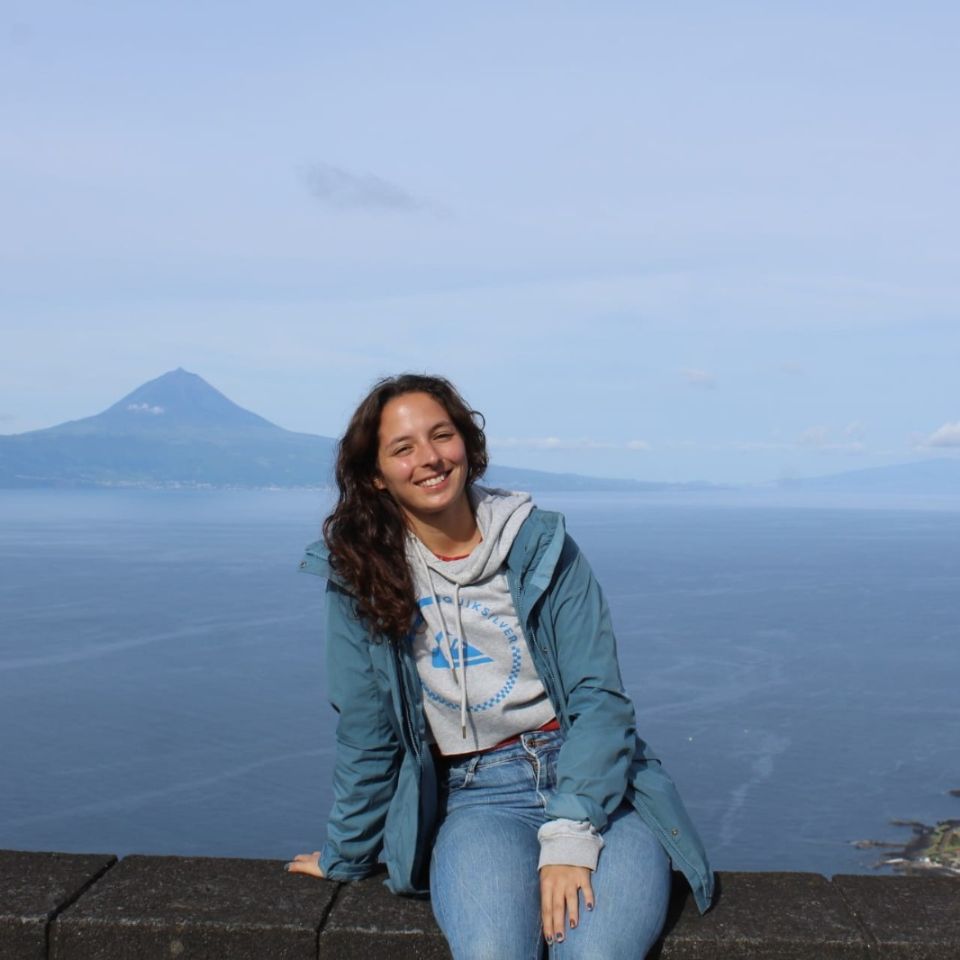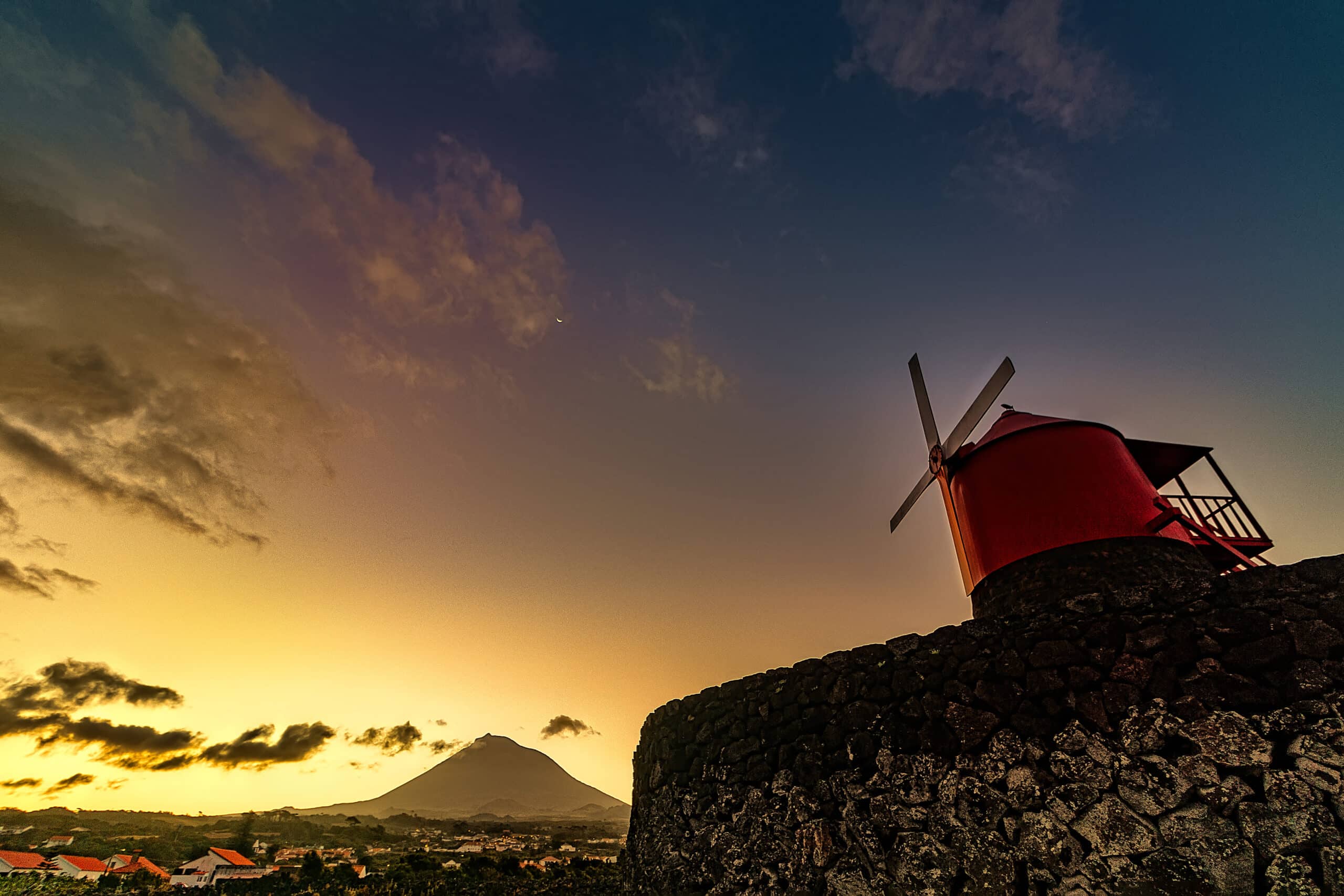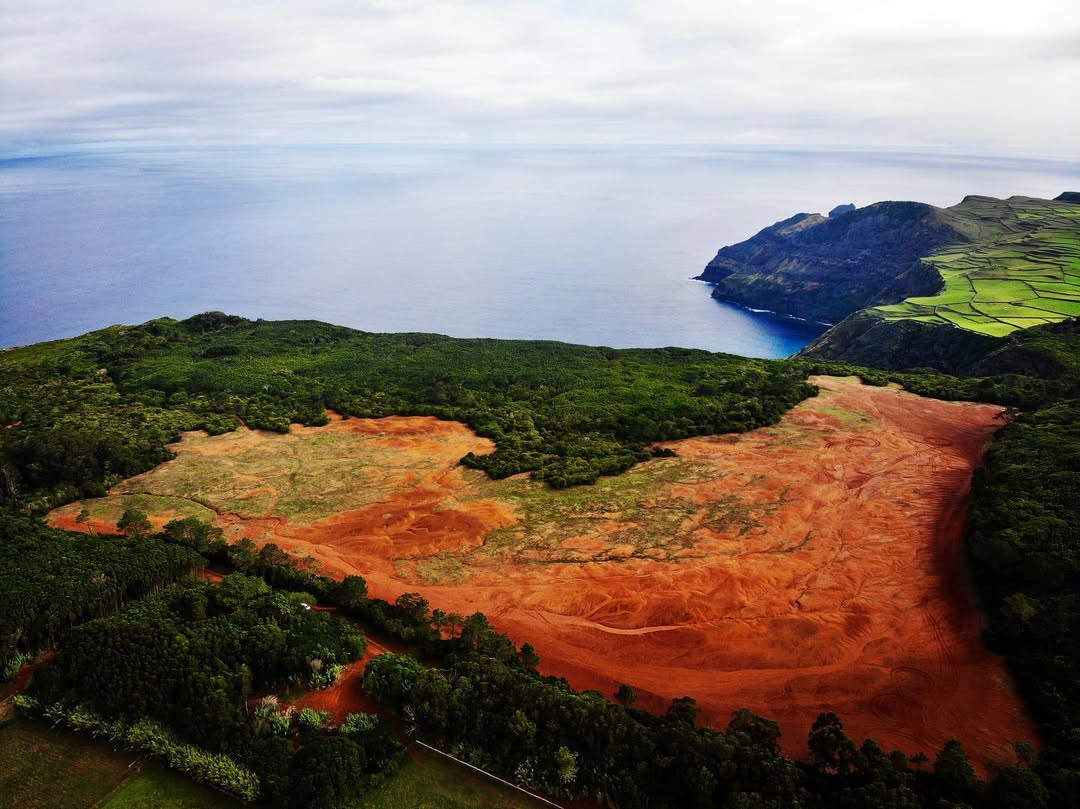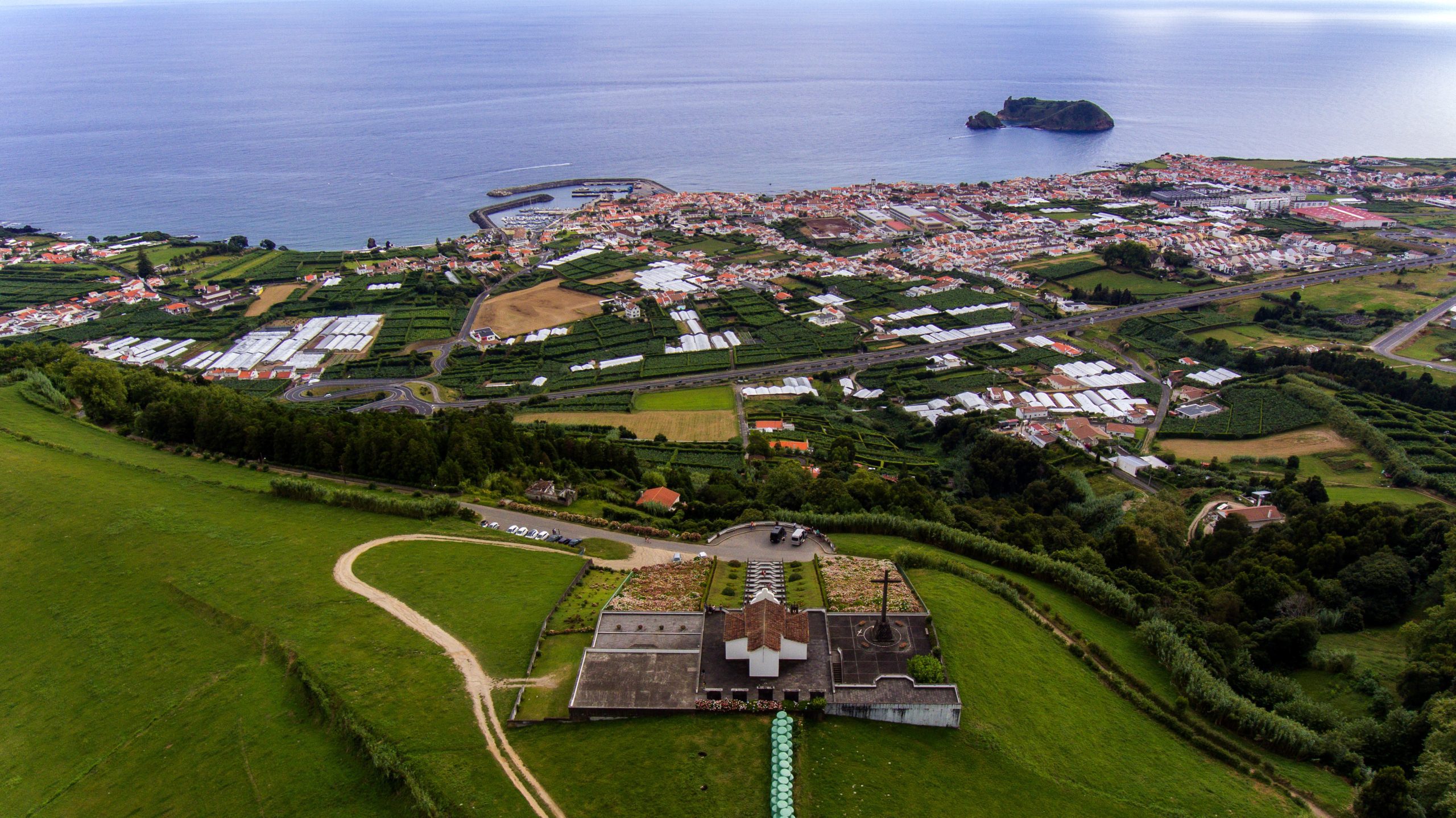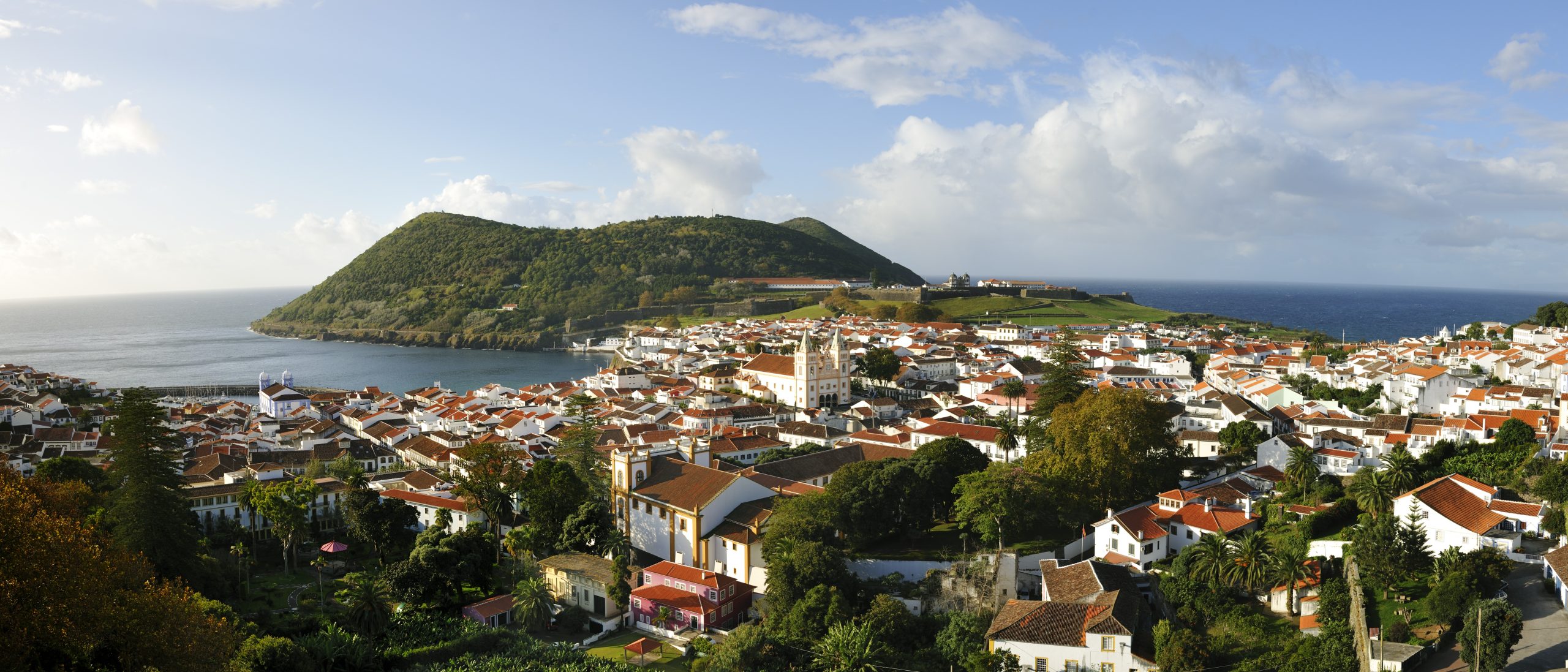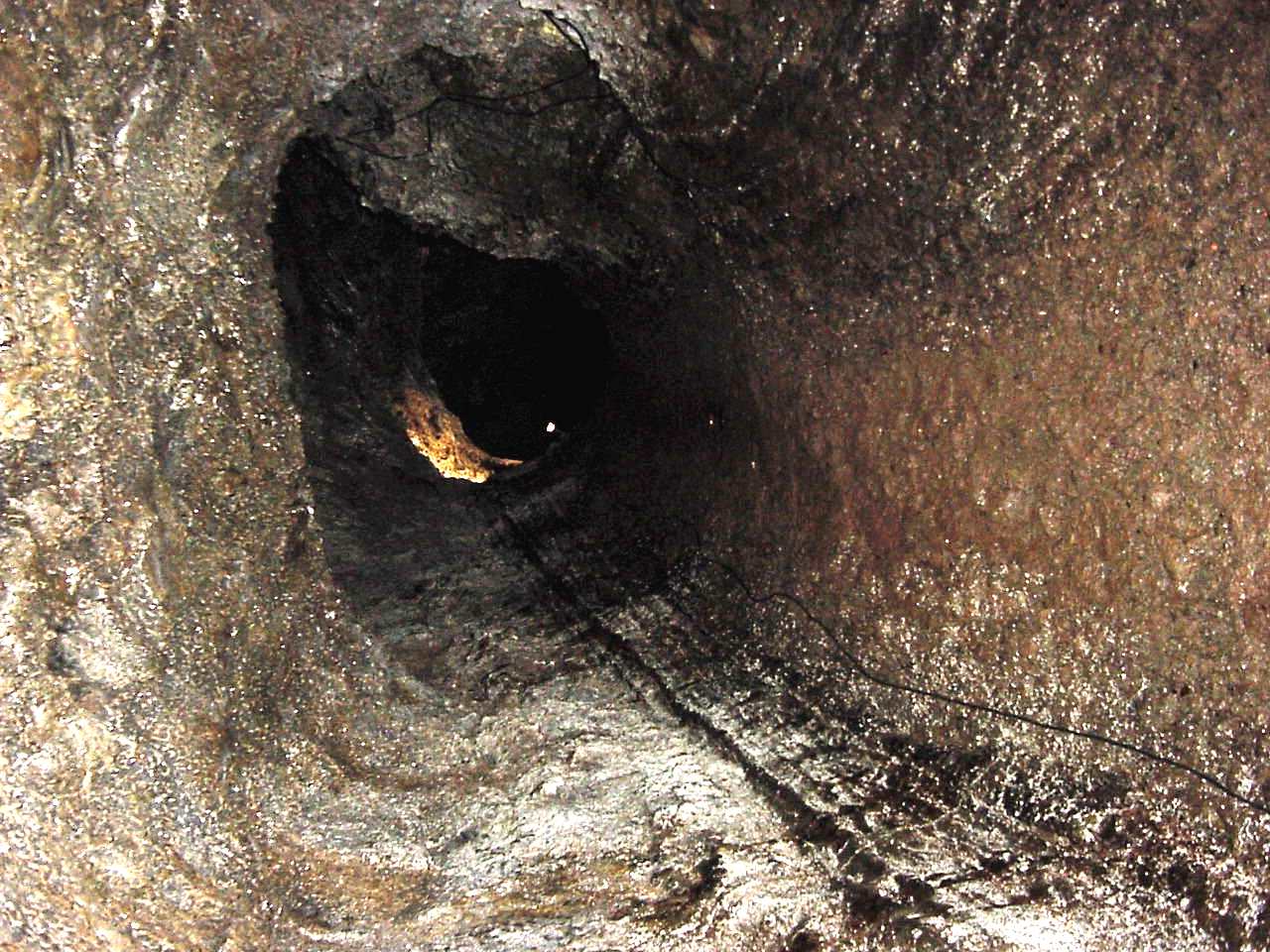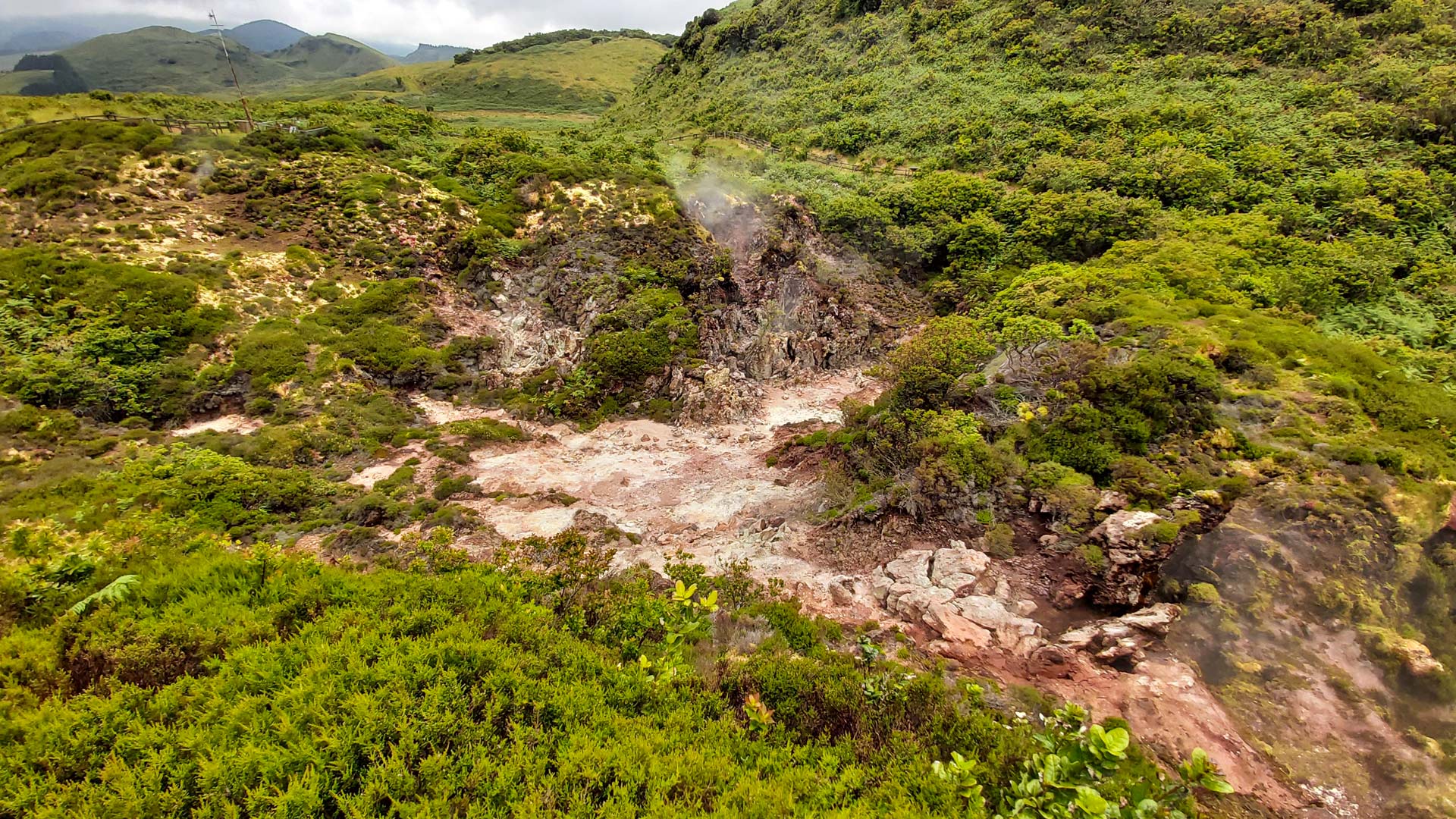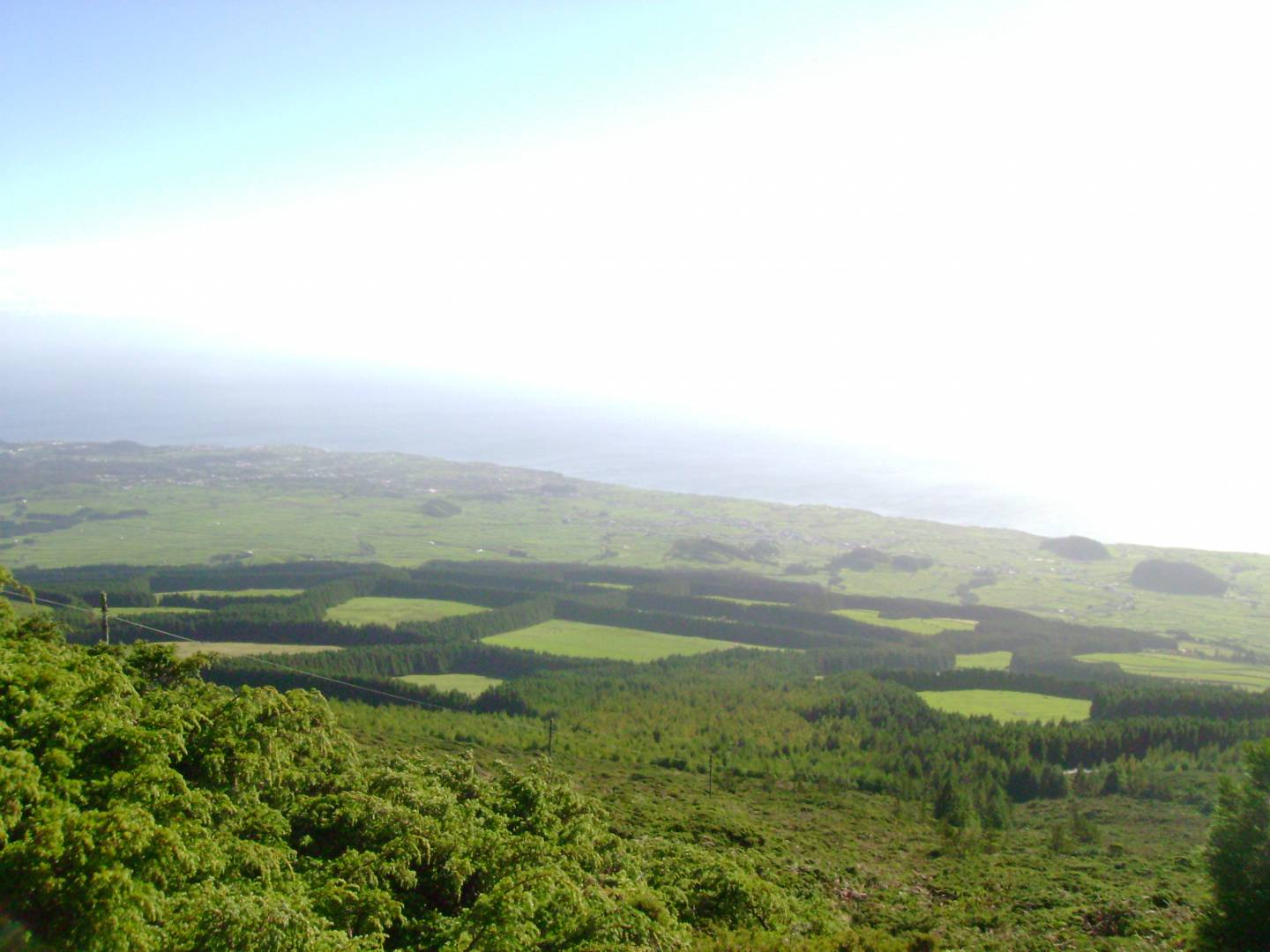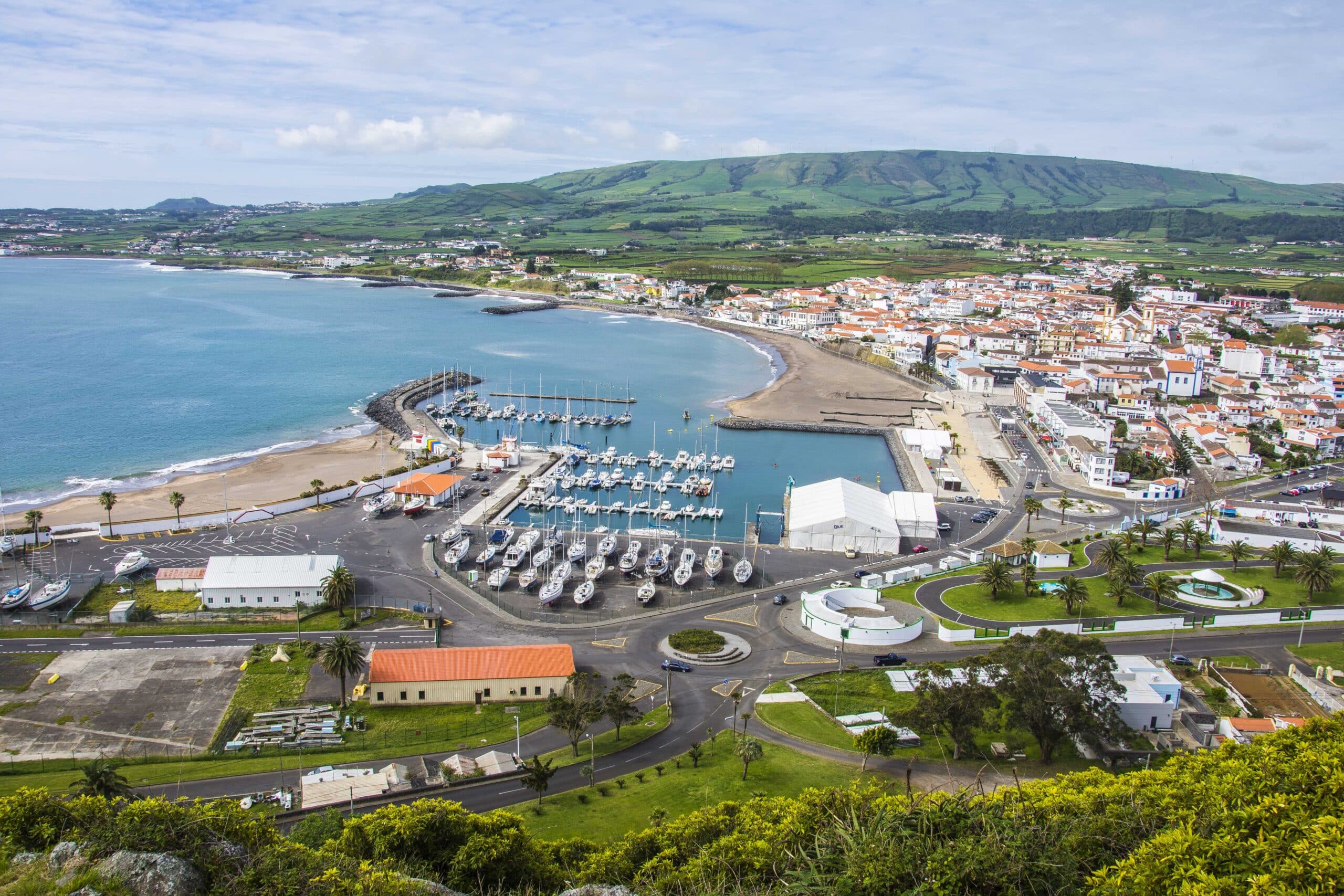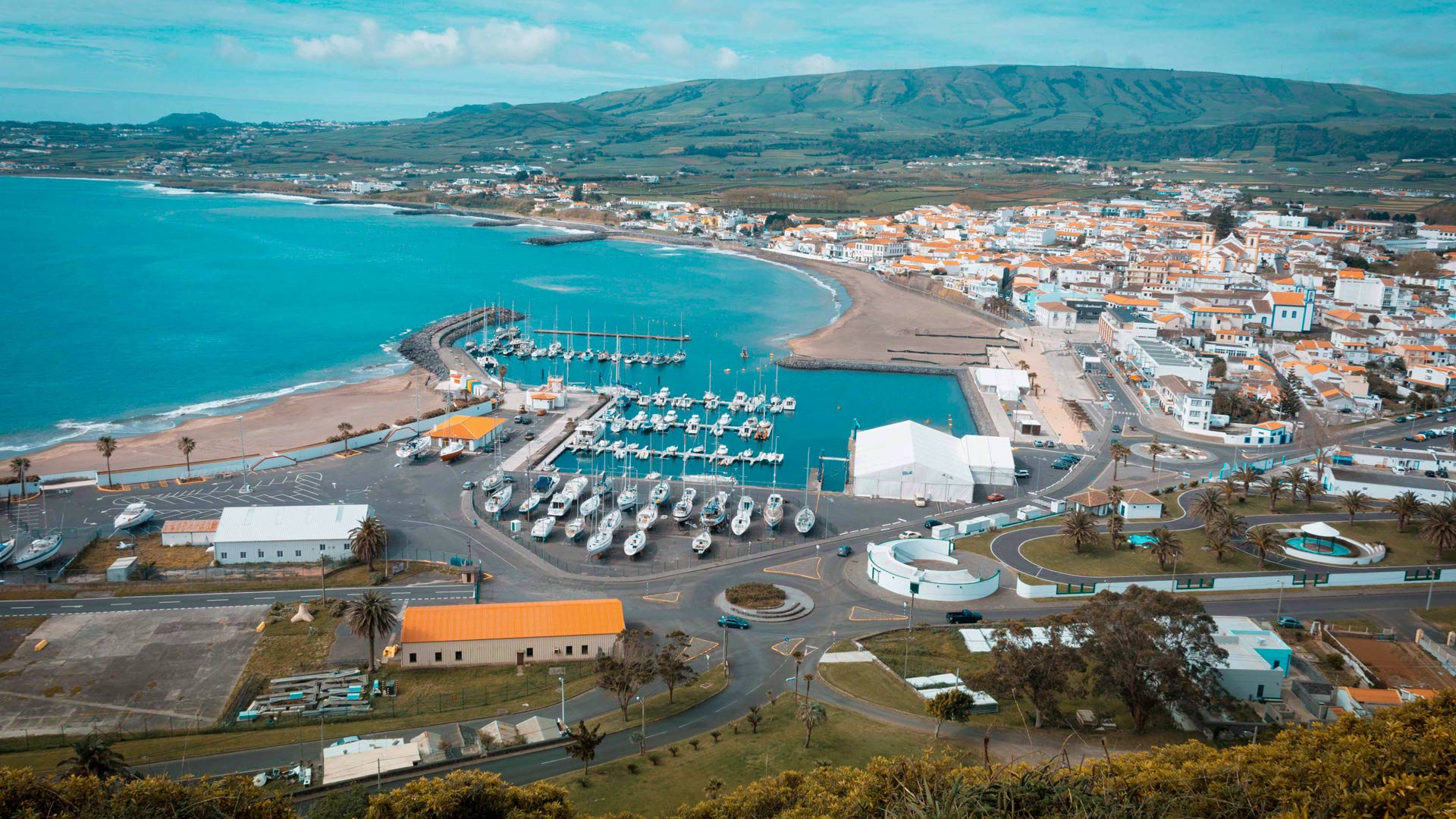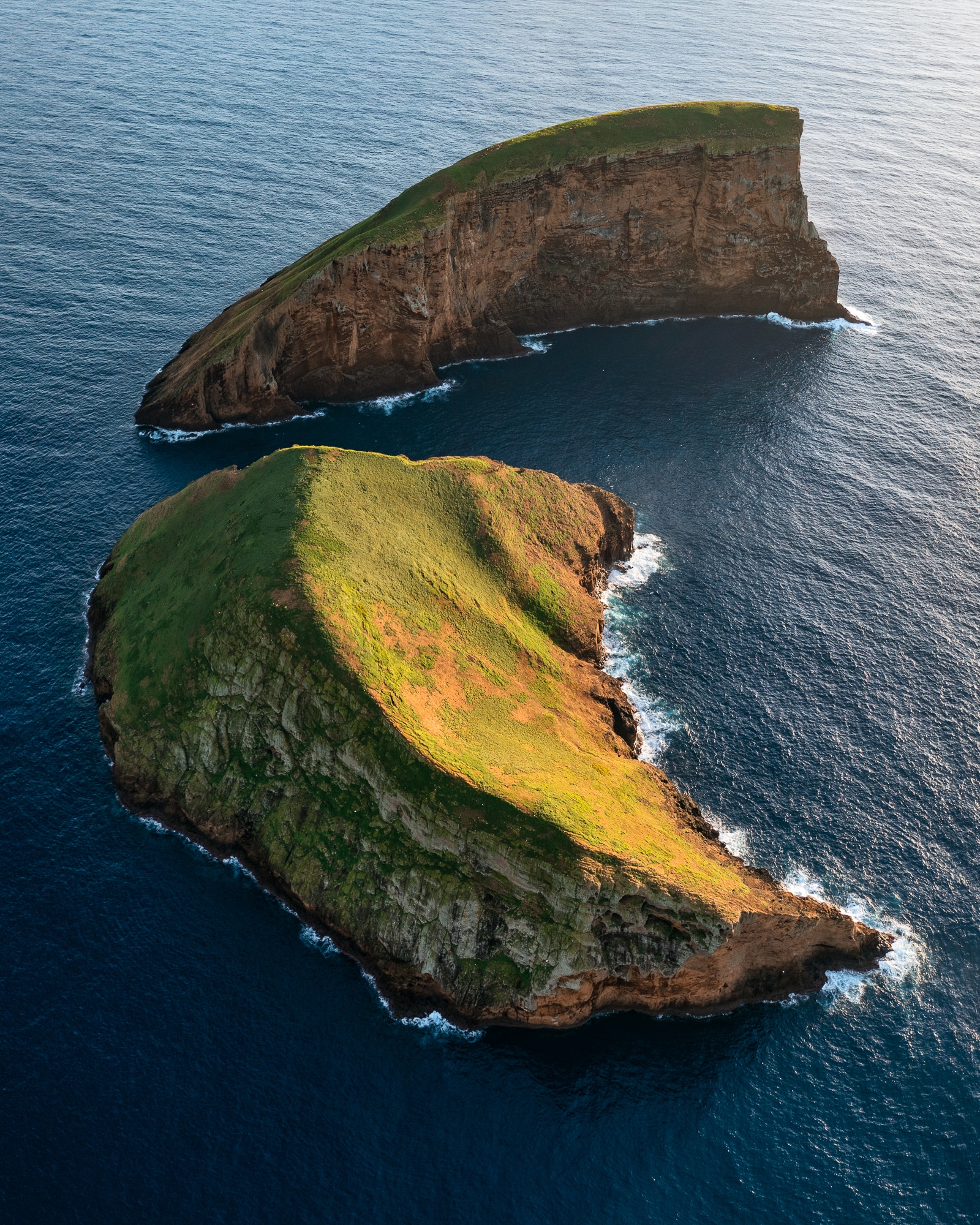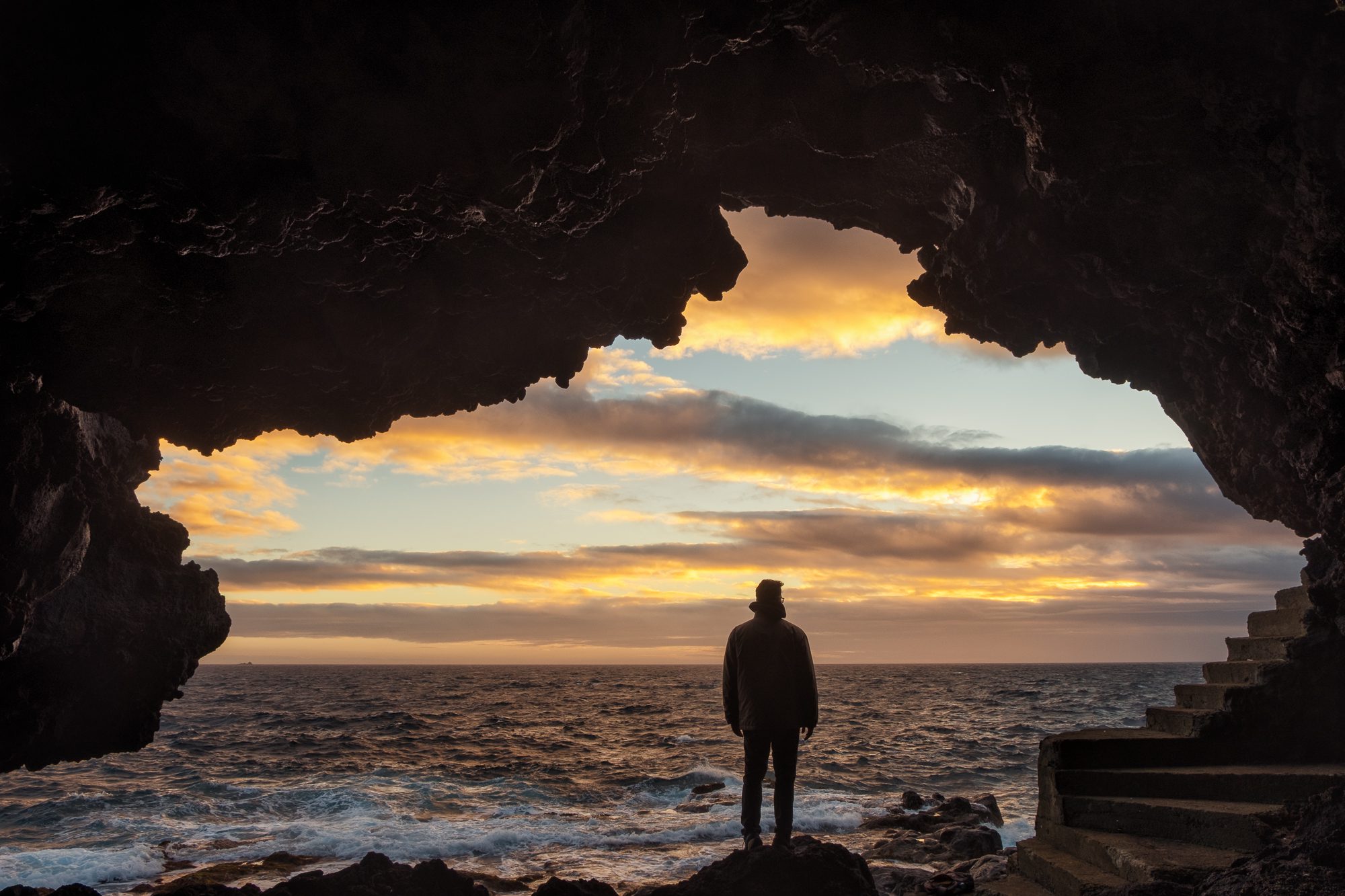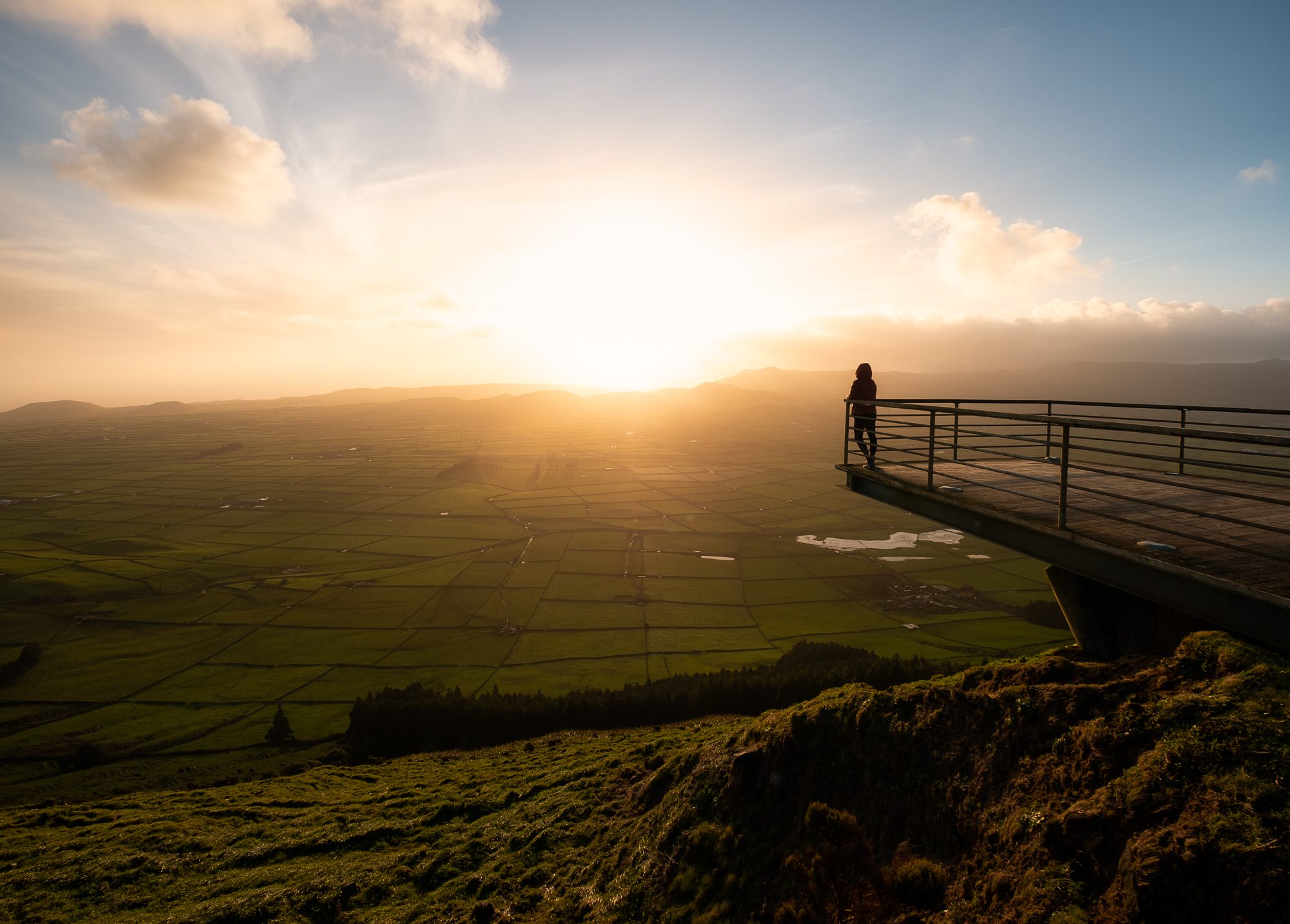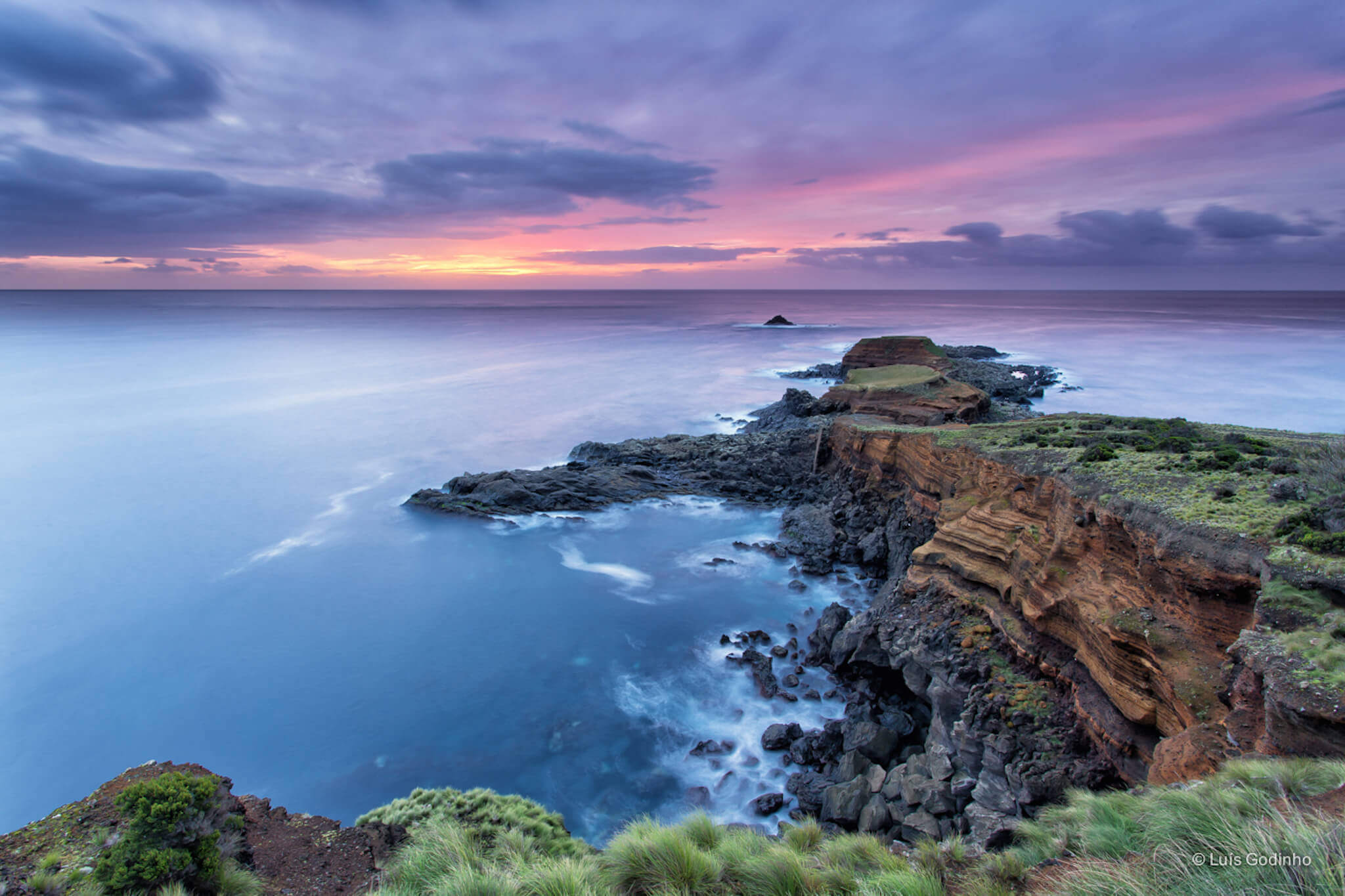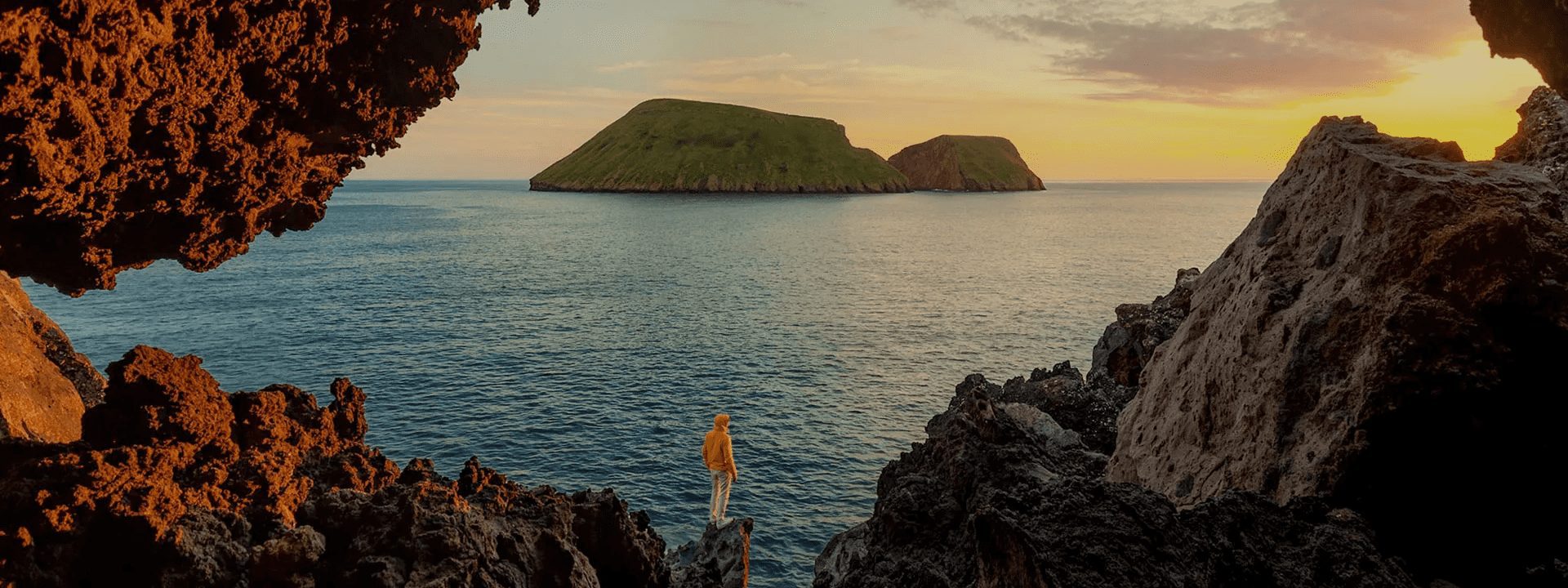Imagine being able to visit the inside of a volcano. ‘Impossible!’ you might think. Well, in the Azores, everything is possible. Indeed, Algar do Carvão in Terceira Island provides a once-in-a-lifetime experience with its open crater. In this post, we will learn everything you need to know about the fascinating cave. Lace your walking shoes, and let’s go on this unique adventure!
What is Algar do Carvão
Algar do Carvão is a 90-meter-deep volcanic chimney in the central group of islands in the Azores archipelago. It was formed about 3,200 years ago due to several eruptions. Nowadays, Algar do Carvão is a tourist highlight not to be missed when visiting Terceira. All year round, many travelers from all over the world venture into the earth’s depths from this cave, recognized as a Regional Natural Monument.
Geology & Volcanology
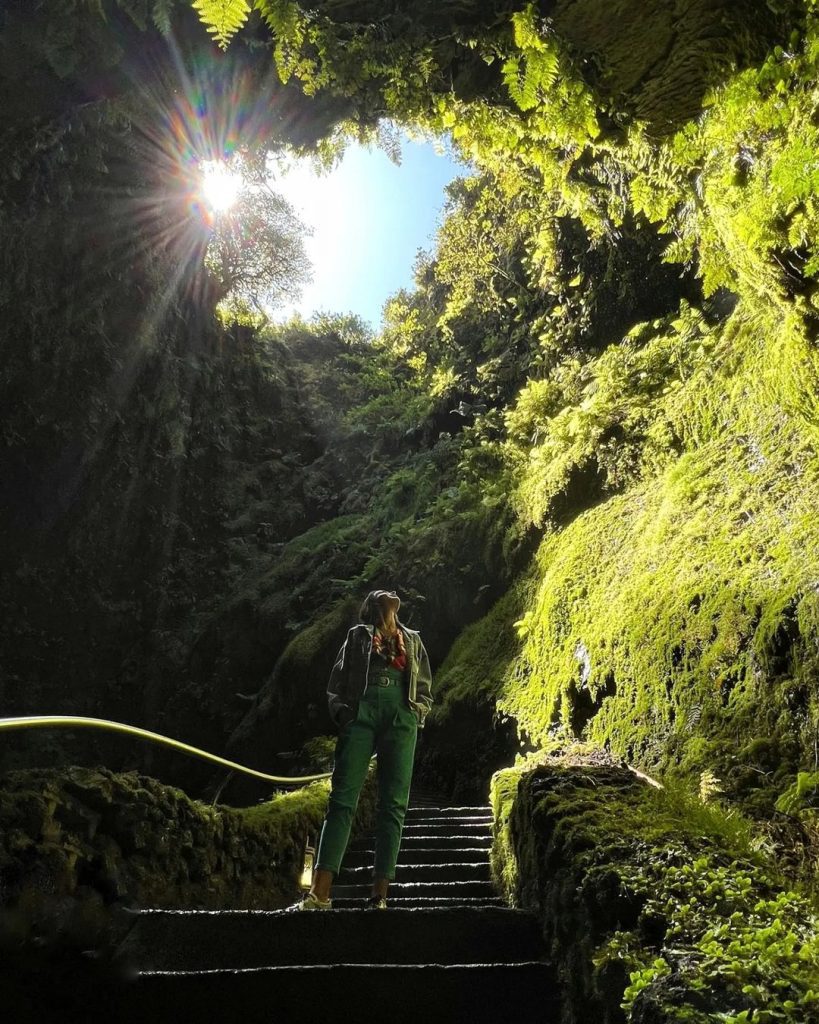
The cave was created after the magma drained from the chimney and flowed back into the chamber. The first big eruption leading to Algar do Carvão is known as Pico Alto. It occurred North of the Guilherme Moniz volcanic complex and spread lava far away. However, later, a basaltic eruption created the strombolian volcano Pico do Carvão and the current Algar as we know it today, including the lake area.
Algar do Carvão is a true geological wonder. Thanks to its uniqueness, it gained international scientific fame and is now a significant Geosite of the Azores Geopark.
→ Similar Travel Articles: Caldeira Velha | Ilhéu de Vila Franca | Lagoa do Congro | Lagoa do Fogo | Monte Palace Hotel | Ponta da Ferraria | Ribeira dos Caldeirões | Vista do Rei Viewpoint
History & Geography

The first explorers, Cândido Corvelo and José Luís Sequeira, entered the cave in 1893. In 1934, Didier Couto created the profile of Algar do Carvão. At that time, the only way to explore it was to use a rope.
Organized descents to the cave began only in 1963, thanks to the association still in charge of this place: Os Montanheiros (The Mountaineers). This group of local enthusiasts revealed the beauty of Algar do Carvão to the world and initiated construction to facilitate easier access and thorough exploration of the cave.
As visiting the cave would have taken a whole day at that time, they decided to open a 44-meter-long tunnel in 1966 and build the current 300-meter-long staircase in 1977. This natural monument is situated in the central area of Terceira, within the vast volcanic formations that comprise the island. The total area of Algar do Carvão is 40,5 acres.
Culture & Festivities
Representing a tremendous natural stage perfect for echoing music, Algar do Carvão has already hosted several live concerts by popular national bands. For instance, in 2017, the group Fado Preto Fado Branco performed beautiful traditional Fado songs. Algar do Carvão has hosted not only musicals but also cultural and religious events, such as the celebration of the Eucharist. This place also attracts many TV reporters for documentaries.
Fauna & Flora

Algar do Carvão may appear inhospitable for life, but a closer look reveals that it is home to many bird species. Mostly at night, it is possible to spot sparrows, common blackbirds, and chaffinches. Occasionally, you can also see rabbits that fell off the crater edge, and of course, many arthropods (insects).
In terms of flora, the cave shows an abundance of vegetation in the green crater walls. Between the plants, you can find Macaronesian holly, Erica azorica, Azores laurel, Azores blueberry, and ferns. There is also ivy, carex, brown wort, and many types of mosses and liverworts. Deeper down, only some ferns, Bryophyta, and diatoms are surviving the darkness.
What to Do at Algar do Carvão
You can visit Algar do Carvão all year round for about 30 minutes of exploration. It is definitely something to add to your must-sees on Terceira Island. Nowadays, there is light and an indicated path for a safe visit. A maximum of 150 people is allowed inside the cave at a time, but no booking is required. You can purchase your ticket at the entrance.
Enter the Cave
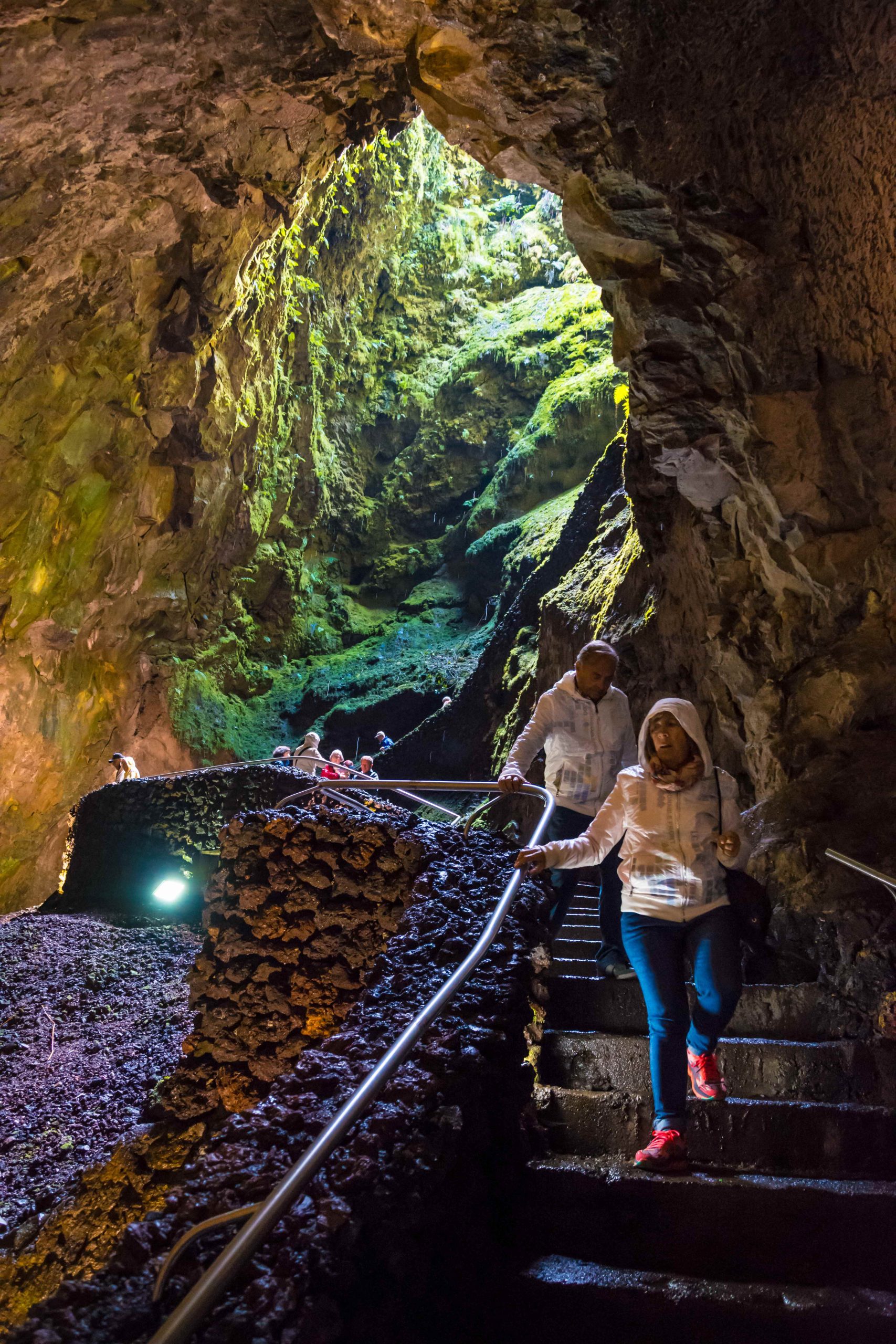
When you enter the visitor center, you will go down the stairs and cross the tunnel to the inside of Algar do Carvão. There are 338 steps in total connecting the different balconies. The floor is concrete, so it is an easy walk. The chimney is the only source of natural light inside the cave. It is the perfect spot to take beautiful pictures of the famous crater, which is surrounded by lush vegetation.
Explore the Inside of Algar do Carvão

Welcome to the underground wonderland! Inside Algar do Carvão, it is like walking on another planet. Nothing resembles our world. There are impressive stalactites, which serve as evidence of the eruption that gave rise to the cave.
If you continue straight, you will find the Boca dos Enganos, which is a dead end. There are also some restricted access areas for research and preservation purposes. Look around and find the magnificent whitish walls with some red veins. The rocks are rich in ferric and silica minerals, and you can also see some basalt layers.
Go to the Lake

At the bottom of the 90-meter-deep chimney lies a lake with crystal clear waters. The lake is mainly filled with rainwater, so the depth varies according to the seasons. It can reach depths of up to 15 meters and diameters of 400 square meters. During the years with little rain, the lake can become almost dry.
Researchers once found a perfectly preserved fossil of a seabird covered in silica at the bottom of the lake. The lake in Algar do Carvão is beautiful, but you can only see it from a distance. Note that swimming in the lake is forbidden.
Back to the Visitor Center
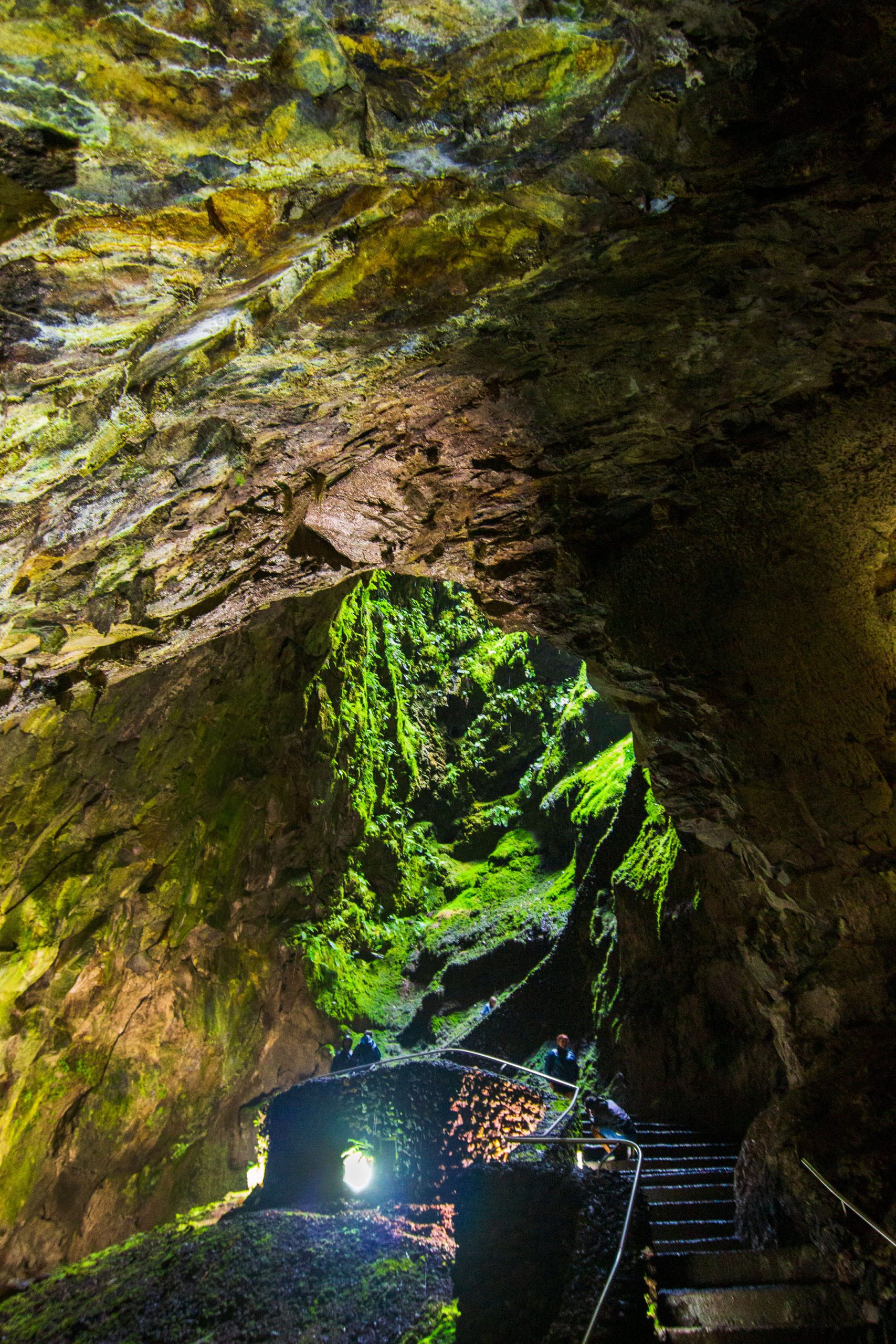
After visiting all the parts of the cave, it is time to return to the visitor center. Look around one last time and climb the 80-meter elevation. The center is small, but a construction project for a new center with a budget of 1.5 million euros is underway. It will be significantly larger — 900 square meters — and will focus on educational exhibitions to raise awareness of this vital natural treasure.
Best Time to Visit Algar do Carvão
You can visit the Algar do Carvão every month of the year. However, there are some significant differences you should be aware of to choose the right time to explore the cave.
Check all our articles about the weather in the Azores throughout the year 🌤️ ☔️: January | February | March | April | May | June | July | August | September | October | November | December
Best Season
During the off-season, the cave is only open on certain days of the week. If you are visiting Terceira for only a couple of days, ensure Algar do Carvão is open during your stay. So, summer is the best season for more flexibility. However, in the summer, the cave can get a bit crowded, as there are more tourists than in the other seasons.
Best Time of the Day
If you want to have the place to yourself or with a few people, the best time to visit is during the opening hours. How amazing can it be to stroll inside a volcano on your own? For the most light, around midday is probably your best bet. However, when the sun sets, the golden light creates a unique atmosphere.
Plan Your Visit to Algar do Carvão
In this section, we’ll share tips on how to make the most of your time and enjoy every moment of Algar do Carvão. Keep reading for the best tips.
How to Get to Algar do Carvão
The volcanic cave of Algar do Carvão, located at an altitude of 640 meters, is situated in the middle of the island of Terceira. It belongs to the Porto Judeu parish, located 12 km north of Angra do Heroísmo city. Access is relatively easy and well-marked. However, you need a car to get there, as there is no public transportation to Algar do Carvão. Therefore, your best options are to rent a car, go on a guided tour, or take a taxi.
Planning a trip to the Azores? These articles will help you: How to Get to the Azores 🗺️ | Azores airports 🛬 | Flights between islands ✈️ | Ferries between islands ⛴️ | Which island to choose? 🏝️ | What airlines fly to the Azores? 🛩️
Where to Eat
Click on the following link to find a place to eat near Algar do Carvão. It will take you to TripAdvisor, where you can review the 10 best restaurants.
Where to Stay
Searching for the perfect place to stay? We’ve made it easy by filtering top accommodation options from Airbnb and Booking. Here, you’ll find the ideal place to stay and enjoy your visit!
Pro Tips & What to Bring
- At the reception of Algar do Carvão, please ensure you have some cash, as the mobile network is unstable and may affect card payments.
- An essential thing to remember is that collecting geological samples is forbidden. Take nothing but pictures. Regarding photos, tripods are not permitted inside the cave.
- According to their official website, visiting Algar do Carvão is not recommended for babies or lap children. They also don’t recommend that pregnant ladies at an advanced stage of pregnancy enter the cave. If you are traveling with someone who has physical limitations, please notify reception upon arrival before entering the cave.
- As the floor inside Algar do Carvão is often wet, suitable footwear, such as walking boots or sneakers, as well as a raincoat, is highly recommended.
- The average temperature inside the cave is 12°C to 13°C, making it quite cold. Bring appropriate clothing to keep you warm.
Azores Guide Book
Azorean Language & Phrases 🗣️ | Currency & Banks 💵 | Credit Cards & Traveler’s Cheques 🏧 | Driving in the Azores 🚗 | Electricity 🔌 | Experiences & Tours 🗺️ | Health & Safety 🩺 | Internet & Wi-Fi Access 🛜 | Phones & Mobile Service 📞 | Post Offices & Buying Stamps ✉️ | Public Holidays 🏖️ | Shopping 🛒 | Time & Daylight 🕒 | Whale Watching Guide 🐳 | Best Island to Visit 🏞️
What to Do Around Algar do Carvão
Visit Gruta do Natal

When visiting Algar do Carvão, you can buy a combo ticket to explore Gruta do Natal (“Christmas Cave” if translated literally). In 2022, the double ticket costs 12 euros per adult; as of January 1, 2023, it will be 15 euros for the two caves.
Each cave is thoroughly different, and both are worth visiting. While Gruta do Natal is smaller, the visit is a bit longer. In fact, you will have a briefing at the reception and will be given a helmet to enter the cave. Inside, there are two staircases, and you can walk on the original floor, not concrete ground. Access is a bit more complicated, but it provides a great experience that is closer to nature.
Walk Around Angra do Heroísmo

Angra do Heroísmo is the largest city on Terceira, with a population of approximately 10,000 inhabitants. It is characterized by the famous green peninsula of Monte Brasil, located just behind the town, as well as its lovely, narrow streets and colorful houses.
Angra was classified as a World Heritage by UNESCO in 1983. It is so lovely to stroll around and learn more about its rich history through monuments and museums. Among the museums, if you wish to learn more about the geology and volcanology of the island, don’t forget to visit the Volcano Speleological Museum, owned by the Montanheiros Association.
Relax at Biscoitos Natural Pools

The natural pools at Biscoitos, located on the north coast of Terceira Island, are the perfect spot to lay your towel and soak up the sun. Locals and travelers love it there. There are several pools to swim and snorkel in, as well as some spots to jump from the volcanic rocks. The crystal-clear water is ideal for swimming all year round, with the warmer months being August and September.
Stop at Serra do Cume Viewpoint

Serra do Cume is probably the most famous viewpoint in Terceira and one of the most famous in the Azores archipelago. From there, you can see a good part of the island and the ocean. Don’t forget to take pictures from the wooden platform with the view of the green fields, typical of the Azores.
Check all our articles about each one of the most relevant points of interest on Terceira Island: Algar do Carvão | Biscoitos | Furnas do Enxofre | Gruta do Natal | Jardim Duque da Terceira | Lagoa das Patas | Miradouro Serra do Cume | Miradouro da Serra de Santa Bárbara | Monte Brasil | Ponta das Contendas | Praia da Vitória | Gruta das Agulhas | Ilhéus das Cabras | Miradouro do Facho
Video
Complementary Information
Best Season to Visit the Azores
The Azores Archipelago boasts a unique climate that shapes its lush landscapes, making it a splendid year-round destination. With mild temperatures and minimal fluctuations, each season offers something unique. Spring averages 16 °C, summer reaches 21 °C, autumn cools to 18 °C, and winter remains mild at 14 °C.
→ For a detailed breakdown of the weather by month, check the following links 🌤️☔️: January | February | March | April | May | June | July | August | September | October | November | December
How to Get to the Azores
The Azorean Archipelago is easily accessible through numerous flight routes. Lisbon and Porto are the main entry points to the continent, with direct flights available to São Miguel (PDL), Terceira (TER), Faial (HOR), Pico (PIX), and Santa Maria (SMA). To find the best flight, use search engines like eDreams or Skyscanner. These platforms let you compare prices and schedules from multiple airlines in one convenient location.
For more details on how to get to the Azores, take a look at our complete guide. But what if you want to explore beyond your arrival island? We’ve got you covered!
- Azores airports 🛬
- Flights between islands ✈️
- Ferries between islands ⛴️
- Which island to choose? 🏝️
- What airlines fly to the Azores? 🛩️
→ Once you’ve found the perfect route, book your tickets and get ready to experience one of the world’s most stunning island groups!
Travel Essentials
Essential Information for your Azores trip: Azorean Language & Phrases 🗣️ | Currency & Banks 💵 | Credit Cards & Traveler’s Cheques 🏧 | Driving in the Azores 🚗 | Electricity 🔌 | Experiences & Tours 🗺️ | Health & Safety 🩺 | Internet & Wi-Fi Access 🛜 | Phones & Mobile Service 📞 | Post Offices & Buying Stamps ✉️ | Public Holidays 🏖️ | Shopping 🛒 | Time & Daylight 🕒 | Whale Watching Guide 🐳 | Best Island to Visit 🏞️
Useful Tools & Apps
The weather in the Azores can be variable, so it’s helpful to use some apps before visiting the islands. Spotazores provides live camera feeds from the main tourist attractions, allowing you to check the weather and plan your visit. For accurate weather predictions, use Windy or Windguru — they provide the most reliable predictions.
Conclusion
Algar do Carvão, a protected reserve since 1987, receives thousands of visitors every year from all around the globe. It is actually the most visited cave in the Azores, with 60,000 entries in 2019. If this magical place was not on your list of places to visit in Terceira, you definitely need to add it now.
Authors’ Note
I am pleased to inform you that all the recommendations in this article are based on my personal experience and observations. As the author, I have personally visited each attraction mentioned, ensuring that every suggestion is grounded in first-hand knowledge and genuine enthusiasm.
Photo Gallery


